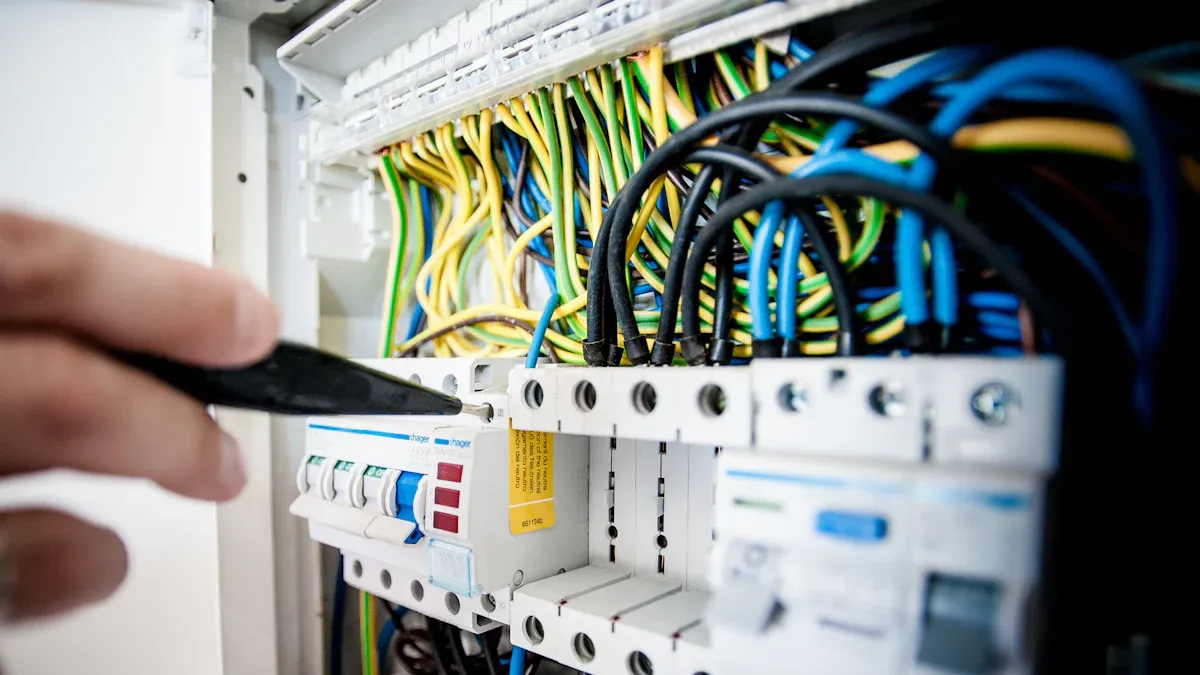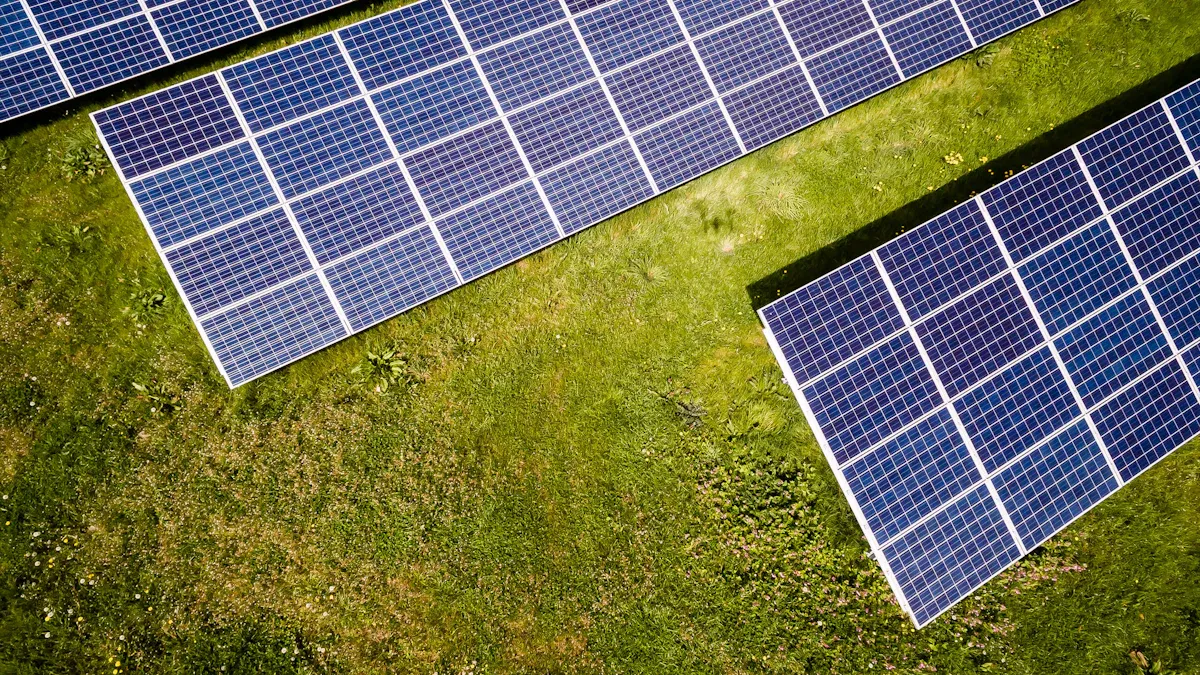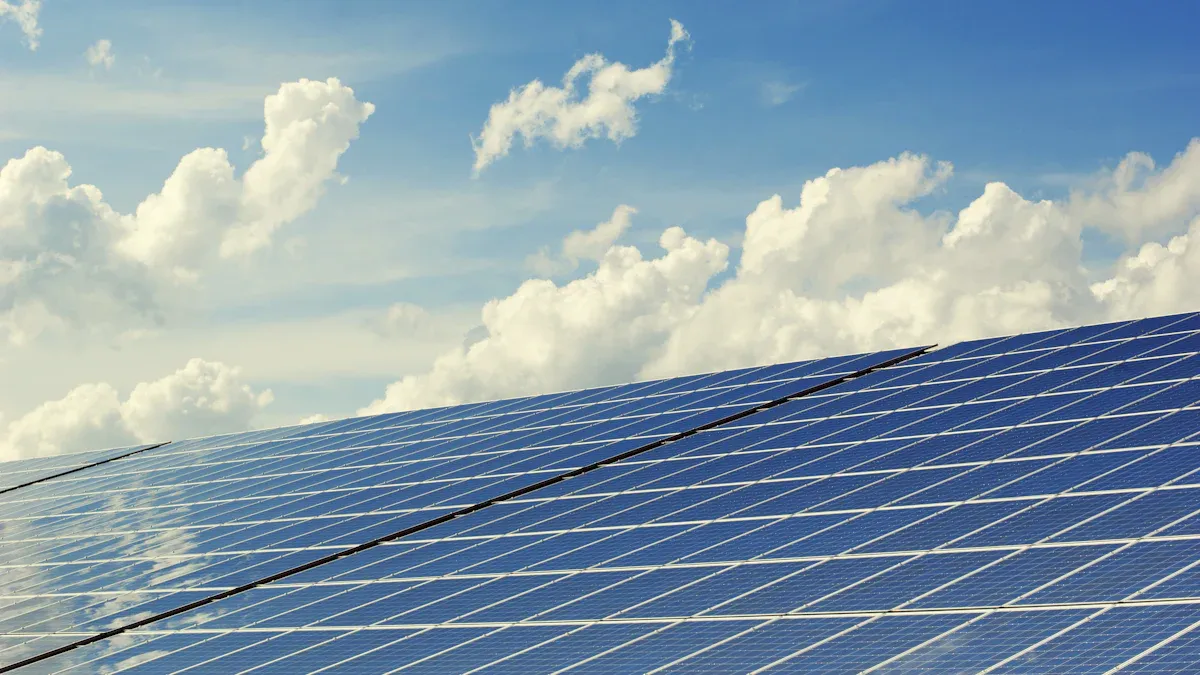
Grid stability plays a pivotal role in Europe’s shift toward sustainable energy systems. Rapid renewable energy adoption and fluctuating demands in commercial buildings create significant challenges. Smart Power Distribution Units offer innovative solutions to monitor, manage, and optimize energy distribution. These devices enhance operational efficiency and ensure a balanced, reliable power supply across dynamic environments.
Key Takeaways
- Smart Power Units (PDUs) make grids stable by sharing energy better.
- They watch energy use in real-time and fix waste quickly.
- Using smart PDUs saves energy and cuts down carbon pollution.
Key Challenges in European Grid Stability
Renewable Energy Integration and Variability
The rapid adoption of renewable energy sources across Europe has introduced significant variability into the grid. Solar and wind power, while essential for decarbonization, depend heavily on weather conditions. For instance, cyclonic weather patterns reduce carbon intensity and enhance renewable generation, whereas blocking patterns increase carbon intensity, limiting efficiency. Additionally, meteorological factors create regional co-variability, where clusters of power systems experience similar fluctuations, while others face opposing trends. These dynamics complicate grid management and require advanced forecasting tools to maintain reliability.
| Evidence Description | Key Insights |
|---|---|
| Impact of meteorological factors on power systems | Climate variability affects renewable energy reliability and efficiency. |
| Co-variability among regions | Positive correlations within clusters; negative correlations between regions. |
| Weather patterns and carbon intensity | Cyclonic patterns lower carbon intensity; blocking patterns increase it. |
Aging Energy Infrastructure
Europe’s energy grid faces challenges from aging infrastructure, which was originally designed for centralized power generation. The transition to decentralized systems, driven by renewable energy integration, highlights the need for modernization. Outdated systems struggle to handle the dynamic demands of renewable energy and advanced technologies. Modern grid management systems and robust supply chain strategies are essential to ensure reliability and efficiency. Without these updates, the grid risks inefficiencies and potential failures.
- The grid is shifting from centralized to decentralized models, requiring modernization.
- Aging systems must be upgraded to support renewable energy integration.
- Advanced management systems are critical for addressing infrastructure challenges.
Demand-Supply Imbalances in Commercial Buildings
Commercial buildings contribute significantly to demand-supply imbalances in the grid. Stochastic variations in energy supply and demand, especially with high renewable penetration, can destabilize prices and supply security. Demand response (DR) programs offer a solution by smoothing price spikes and mitigating system contingencies. These programs, combined with flexible resources, play a vital role in maintaining grid stability.
- Demand response helps balance energy systems and smooth price fluctuations.
- Variations in supply and demand can disrupt prices and security without proper management.
- Flexible resources are essential for stabilizing energy systems with high renewable shares.
The Role of Smart Power Distribution Units

Core Functions of Smart PDUs
Smart Power Distribution Units (PDUs) serve as the backbone of modern energy management systems in commercial buildings. These devices perform critical functions that enhance grid stability and operational efficiency. By intelligently distributing power, they ensure optimal energy flow across various systems and prevent overloads. Their ability to monitor and control energy usage in real-time makes them indispensable in addressing the challenges posed by renewable energy integration and fluctuating demand.
A study comparing different system types highlights the effectiveness of smart PDUs in reducing power losses and improving voltage stability.
| System Type | Power Loss (MW) | Voltage Stability (p.u.) | Energy Procurement Needs |
|---|---|---|---|
| 33-bus | 0.64 to 0.52 | 0.970 to 0.980 | Reduced |
| 69-bus | 0.85 to 0.79 | 0.962 to 0.972 | Reduced |
These results demonstrate how smart PDUs contribute to a more reliable and efficient energy distribution network.
Real-Time Monitoring and Load Balancing
Real-time monitoring is a cornerstone of smart PDU functionality. These devices provide immediate insights into power consumption, enabling facility managers to identify inefficiencies and take corrective actions. For example, smart PDUs allow data center managers to measure, manage, and report energy usage in real-time. This capability supports optimization efforts and ensures that equipment operates at peak efficiency.
The benefits of real-time monitoring and load balancing include:
- Monitoring energy use improves productivity in energy-intensive environments.
- Real-time visibility helps identify inefficiencies and reduce waste.
- Corrective measures based on monitoring data lead to significant energy conservation.
Additionally, smart PDUs excel in load balancing by distributing power evenly across circuits. This reduces energy waste, prevents overloads, and enhances system reliability. High-efficiency transformers within these units improve energy efficiency by 2% to 3%, resulting in substantial cost savings.
| Benefit | Description |
|---|---|
| Real-time Monitoring | Smart PDUs provide immediate data on power usage, helping identify energy-intensive equipment. |
| Load Balancing | Distributes power evenly, reducing energy waste and preventing circuit overloads. |
| Energy Savings | High-efficiency transformers improve energy efficiency by 2% to 3%, leading to cost savings. |
Integration with Renewable Energy Systems
Smart PDUs play a pivotal role in integrating renewable energy systems into commercial buildings. Their advanced capabilities allow seamless synchronization with solar panels, wind turbines, and other renewable sources. By dynamically adjusting energy distribution based on supply and demand, they ensure that renewable energy is utilized efficiently.
A cost analysis conducted by a multinational co-location provider revealed that Packet Power’s Smart Power Cables were 30% less expensive than traditional metered PDUs in the first year and over 70% less in subsequent years. Furthermore, the wireless protocol used by Packet Power ensures effective monitoring without interference from other networks, making it ideal for renewable energy integration.
Smart PDUs also support decentralized energy systems by enabling microgrid functionality. This ensures that commercial buildings can operate independently during grid outages, further enhancing resilience and sustainability.
Benefits of Smart PDUs for Commercial Buildings

Enhanced Energy Efficiency and Cost Savings
Smart Power Distribution Units significantly improve energy efficiency in commercial buildings. By monitoring energy consumption in real-time, they help identify inefficiencies and optimize power usage. For instance, these devices can detect underutilized equipment and automatically adjust power delivery, reducing energy waste. This proactive approach minimizes operational costs while maintaining system reliability.
Additionally, smart PDUs incorporate high-efficiency transformers that enhance energy performance. These transformers reduce energy losses by up to 3%, translating into substantial cost savings over time. Businesses benefit from lower utility bills and improved resource allocation, making smart PDUs a cost-effective solution for modern energy management.
Improved Demand Response and Flexibility
Smart PDUs play a crucial role in enhancing demand response capabilities. Their integration with IoT devices enables real-time monitoring and control of energy systems. This connectivity allows commercial buildings to participate in automated demand response events, improving reliability and flexibility. By 2025, over 75 billion IoT devices are expected to support energy management, further strengthening this capability.
These units also optimize energy consumption by managing power cycling for unused equipment. This feature reduces energy waste and enhances load flexibility, ensuring that buildings can adapt to fluctuating energy demands. As a result, smart PDUs contribute to a more stable and responsive energy grid.
Contribution to Sustainability Goals
Smart PDUs align with sustainability objectives by promoting efficient energy use and reducing carbon footprints. Their ability to integrate seamlessly with renewable energy systems ensures that clean energy sources are utilized effectively. For example, they dynamically adjust power distribution based on renewable energy availability, maximizing its contribution to overall energy needs.
Moreover, these devices support decentralized energy systems, such as microgrids, which enhance resilience and reduce reliance on fossil fuels. By adopting smart PDUs, commercial buildings can achieve their sustainability targets while contributing to broader environmental goals.
Implementing Smart PDUs in Commercial Buildings
Assessing Energy Needs and Infrastructure
Implementing smart PDUs begins with a thorough assessment of a building’s energy requirements and existing infrastructure. This step ensures that the selected devices align with operational demands and support long-term energy goals. Facility managers must evaluate the number of user units, backup power needs, and the capacity of existing systems. This evaluation helps determine the appropriate power mode and ensures compatibility with the building’s energy distribution framework.
The process of assessing and preparing for smart PDU implementation involves several key steps:
| Process Step | Description |
|---|---|
| Selecting | Calculating the power mode based on the number of user units with backup power. |
| Identifying | Identifying components of the distribution point unit that service multiple user units. |
| Supplying | Supplying power to components that provide service to user units. |
| Disabling | Disabling power to components that do not service user units. |
This structured approach ensures that the Power Distribution Unit is tailored to the building’s specific needs, minimizing inefficiencies and maximizing performance.
Integration with Existing Systems
Seamless integration with existing systems is critical for the successful deployment of smart PDUs. These devices must work harmoniously with legacy infrastructure, renewable energy sources, and IoT-enabled devices. Compatibility ensures that the building’s energy management system operates cohesively, avoiding disruptions during the transition.
To achieve this, facility managers should:
- Conduct compatibility tests to identify potential conflicts between smart PDUs and existing systems.
- Upgrade outdated components that may hinder the performance of the new devices.
- Collaborate with technology providers to ensure proper installation and configuration.
Smart PDUs also support modular designs, allowing for incremental upgrades without overhauling the entire energy system. This flexibility reduces upfront costs and simplifies the integration process. By aligning new technologies with existing frameworks, commercial buildings can enhance energy efficiency without compromising operational continuity.
Leveraging Data Analytics for Optimization
Data analytics plays a transformative role in optimizing the performance of smart PDUs. These tools provide actionable insights that enable facility managers to make informed decisions about energy usage and system improvements. Real-time monitoring ensures continuous oversight of energy systems, allowing for immediate responses to anomalies. Predictive analytics, on the other hand, uses historical and real-time data to forecast demand and supply, improving operational planning.
Key benefits of data analytics in smart PDU optimization include:
- Real-time Monitoring: Continuous oversight of energy systems enables quick identification and resolution of inefficiencies.
- Predictive Analytics: Forecasting tools improve demand-supply alignment, reducing energy waste.
- Operational Optimization: Enhanced resource allocation boosts efficiency across energy production, transmission, and distribution.
For example, a smart PDU equipped with advanced analytics can identify underutilized equipment and adjust power delivery accordingly. This reduces energy waste and extends the lifespan of critical components. By leveraging these capabilities, commercial buildings can achieve higher levels of efficiency and reliability, contributing to a more stable energy grid.
Broader Impacts on the Energy Ecosystem
Supporting Decentralized Microgrid Networks
Smart Power Distribution Units (PDUs) play a vital role in enabling decentralized microgrid networks. These networks consist of localized energy systems that operate independently or in conjunction with the main grid. Smart PDUs enhance microgrid functionality by managing energy flow efficiently and ensuring seamless integration with renewable sources.
Note: Decentralized microgrids improve energy reliability during grid outages and reduce dependency on centralized power systems.
Smart PDUs also support peer-to-peer energy trading within microgrids. This feature allows commercial buildings to share surplus energy with nearby facilities, fostering a collaborative energy ecosystem. By promoting energy independence and flexibility, smart PDUs contribute to the growth of decentralized networks across Europe.
Promoting Resilient and Future-Proof Energy Systems
Resilience is a cornerstone of modern energy systems. Smart PDUs strengthen this resilience by providing real-time monitoring and adaptive load management. These capabilities allow energy systems to respond quickly to disruptions, such as equipment failures or fluctuating renewable energy supply.
Smart PDUs also future-proof energy systems by supporting emerging technologies. Their compatibility with IoT devices and advanced analytics ensures that commercial buildings can adapt to evolving energy demands. This adaptability reduces the risk of obsolescence and prepares energy systems for long-term sustainability.
Advancing Europe’s Energy Transition
Europe’s energy transition relies on innovative technologies to achieve decarbonization goals. Smart PDUs accelerate this transition by optimizing energy efficiency and integrating renewable sources. Their ability to reduce energy waste and enhance grid stability aligns with Europe’s commitment to a sustainable future.
Tip: Adopting smart PDUs helps commercial buildings meet regulatory requirements for energy efficiency and carbon reduction.
By facilitating the adoption of clean energy solutions, smart PDUs play a pivotal role in advancing Europe’s vision of a greener, more resilient energy ecosystem.
Smart PDUs tackle grid stability challenges by optimizing energy distribution and integrating renewable sources. Their benefits include improved energy efficiency, reduced costs, and alignment with sustainability goals.
Call to Action: Stakeholders should embrace smart PDUs to future-proof energy systems and contribute to Europe’s sustainable energy transition. Their adoption ensures resilience and operational excellence.
FAQ
What are the key features of smart Power Distribution Units (PDUs)?
Smart PDUs offer real-time monitoring, load balancing, and seamless integration with renewable energy systems. These features enhance energy efficiency, reduce costs, and improve grid stability.
How do smart PDUs contribute to sustainability goals?
Smart PDUs optimize energy use and integrate renewable sources. They reduce energy waste, support decentralized systems, and help commercial buildings achieve carbon reduction targets.
Are smart PDUs compatible with existing energy systems?
Yes, smart PDUs integrate with legacy infrastructure, IoT devices, and renewable energy systems. Modular designs allow incremental upgrades, ensuring compatibility and minimizing disruptions during implementation.
Post time: May-06-2025

